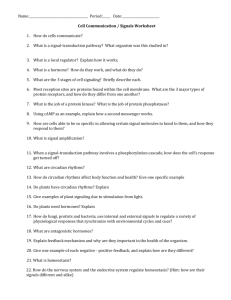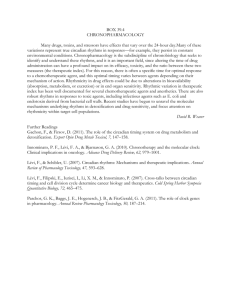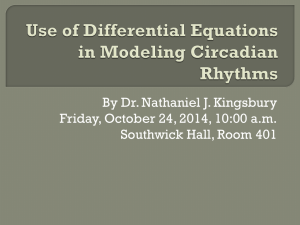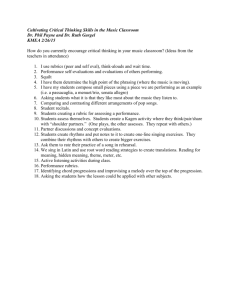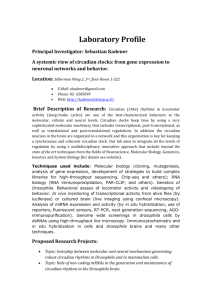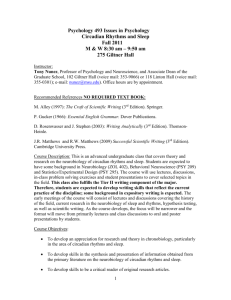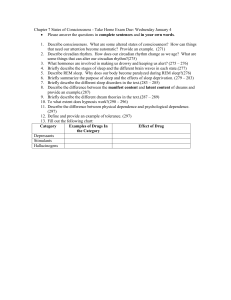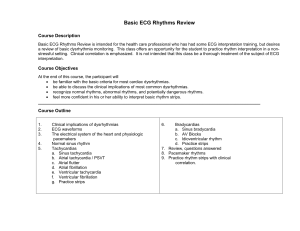Menstrual cycle - The Grange School Blogs
advertisement
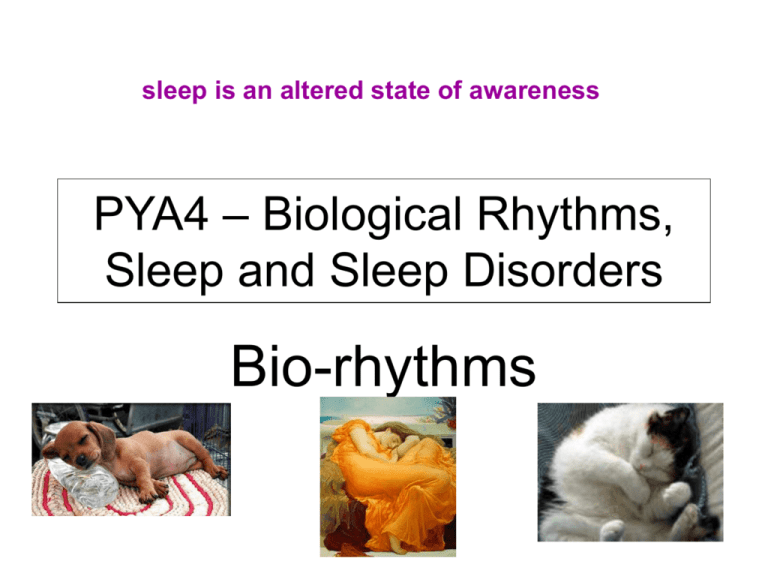
sleep is an altered state of awareness PYA4 – Biological Rhythms, Sleep and Sleep Disorders Bio-rhythms Lessons 1 and 2 : Bio-rhythms BATs AO1 - Define and compare circadian and infradian rhythms A02 - Evaluate the findings of research into circadian and infradian rhythms Starter Are you a morning or an evening person? Do you find it easier to get up early or stay up late? lark OR Bio-rhythms You may have heard of the term ‘internal body-clock’ What do you think is meant by this? Discuss in your group examples of events and bodily functions that seem to follow a cycle? http://www.bbc.co.uk/science/humanbody/sleep/crt/ what’s your daily rhythm? This is on the blog if you want to try this at home The behaviour of living organisms (plants and animals) is governed by biological rhythms. • Circadian rhythms – 1 day • Infradian rhythms - > 1 day • Ultradian rhythms - < 1 day “ ..the 24 hour circadian rhythm evolved because the earth revolved” natural rhythms - the cyclic seasons, the rise and fall of the tides - due to the orbit of the earth & gravitational pull. Circadian rhythms • Latin – ‘Circa’ (about), ‘dies’ (a day) • Most bodily functions – e.g digestion, body temperature, heart rate, immune function, hormone levels show a 24 hour cycle. • 24 hr ‘sleep-wake’ cycle common to nearly all animals. • Regulated by an internal biological ‘clock’ that is readjusted everyday as environmental time cues change (day length, seasons). Some animals sleep all day and are awake all night!! Bodily Rhythms • Endogenous pacemakers – The internal ‘body clocks’ that generate biological rhythms – External factors that regulate or alter biological rhythms We will return to these at a later date www.psychlotron.org.uk • Exogenous zeitgebers Research into Circadian Rhythms Watch the video clip and read ‘Cave Man’ and ‘sleep wake cycle’ info on p2 and 3 1. What is meant by ‘free running?’ 2. Briefly outline the work of Michel Siffre (1975) 3. Outline the findings of Aschoff and Wever (76) and Folkard et al (85) 4. In pairs evaluate the research Research into Circadian Rhythms 1. What is meant by ‘free running?’ Biorhythm not affected by external cues, biorhythm governed by internal (endogenous) ‘clock’ 2. Briefly outline the work of Michel Siffre (1975) Spent time underground in caves, no external cues, woke , ate slept when he felt like it. Regular circadian rhythm just over 24hrs. At 60 tested the effects of age – internal body-clock slows with age 3. Outline the findings of Aschoff and Wever (76) and Folkard et al (85) Aschoff – 22-24hr (some 29hrs) circadian rhythm, Folkard – most ppts maintained 24 hr rhythm even when clocks were changed to a 22 hr day 4. In pairs evaluate the research Artificial light can act as an exogenous zeitgeber Ceizler ’99 Indiv differences range of cycles from 13-65 hrs, ‘larks’ and ‘owls’ can affect cycle onset Infradian rhythms Cycles that have a period greater than 24hrs, but less than a year e.g: • Menstrual cycle – females • Male monthly cycle! – body temperature and mood/alertness • Seasonal Affective Disorder (SAD) – also known as a circannual rhythm The Menstrual Cycle Hypothalamus GnRH Pituitary Gland FSH & LH www.psychlotron.org.uk Ovaries & Uterus Menstrual cycle Driven by fluctuating hormone levels. Regulates ovulation Pituitary gland in the brain releases FSH and LH which stimulate a follicle in one ovary to ripen and release an egg and release the hormone oestrogen. FSH = follicle stimulating hormone After 2 weeks, if no pregnancy, levels of progesterone fall and the lining of the uterus is shed Once ripe the ruptured follicle releases progesterone causing the uterus lining to prepare for pregnancy by increasing blood supply. LH = Luteinising hormone The Menstrual Cycle Hormone Levels FSH ovulation www.psychlotron.org.uk LH The Menstrual Cycle • Generated by the hypothalamus • Fluctuations in hormone levels affect: – Internal biology (ovulation, menstruation) – Sexual behaviour (optimal for conception) – Possible pheromonal mechanism – Possible evolutionary advantage www.psychlotron.org.uk • Apparently influenced by zeitgebers The Menstrual Cycle Sexual Activity Birth control ovulation Adams et al (1979) www.psychlotron.org.uk No birth control Can external cues affect the menstrual cycle? • Anecdotal (non-scientific) evidence that menstrual cycles of women living together for long periods can synchronise. • Russell, Switz and Thompson (80) – found when sweat from one woman was rubbed onto the upper lip of another their cycles synchronised • Sweat contains PHEROMONES which acted as exogenous zeitgebers Male monthly rhythm • Empson (1977) - 21 male participants had body temperature and mood measured over periods varying from 49102 days. • Findings showed evidence for periodic variation in body temp and subjective ratings of morning alertness. • Cycle length of approx 20 days Seasonal Affective Disorder (SAD) • A depressive condition which comes on during the winter months and is gone in the summer. • Symptoms more severe than the normal lowering of mood when daylight hours are shorter. • Research shows that the hormone melatonin is secreted when it is dark. The more darkness the more melatonin. • Melatonin (secreted by the pineal gland in the brain) is related to chronic depression. Summarising Infradian Rhythms • Read about Infradian Rhythms on p4 and 5 of the Complete Companion • Answer questions 3 and 4 on p5 – you could use the same headings as in the book to help you Plenary • Fill in the blanks on the sheet about Circadian Rhythms A Circadian Rhythm: The Sleep–Wake Cycle Copy and fill in the blanks. A circadian rhythm repeats in a cycle of once every 24 hours. Mammals possess about 100 circadian rhythms. The 24-hour sleep–wake cycle is a good example of a circadian rhythm because it clearly illustrates that circadian rhythms depend on an interaction of physical and psychological processes. The fact that we maintain a fairly consistent sleep pattern suggests an internal mechanism, the biological clock. However, this can be overridden by psychological factors, e.g., anxiety can disrupt the sleep pattern. When the internal clock is free of external cues, e.g. clocks, daylight and social cues it is said to be ‘freeRunning’. Applying Knowledge • Read about Core body temperature and Hormones on p 2 and 3 • Add notes to the sheet you filled in about the sleep-wake cycle • Choose to find out more about ….. • Chronotherapeutics see p3 • Or Phototherapy to treat SAD see p5 We will share what you find out in 35 mins Homework In next week please • Learn the definitions of each type of biorhythm and key words. • Are explanations of biological rhythms deterministic? To what extent is this a good or a bad thing? (see p5 Complete Companion) – 8 marks AO2/3 • Research methods worksheet or complete collecting data for experiment ready for next week
